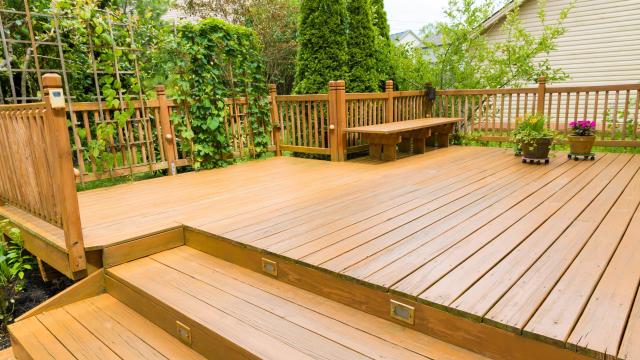Decks can be a popular addition that allows you to better enjoy your outdoor space — and to increase the value of your home. But when it comes time to choose between composite, hard wood, and even hybrid, there are several factors to consider, including cost, durability, and aesthetic.
Different types of deck materials
The two main types of deck boards you can buy are composite, which can cost anywhere between $60 and $100, and timber, which averages between $12 and $35 per metre. There are also hybrid deck boards that have both elements and are popular in Europe, but are becoming more available in the U.S., as well. Within these categories, there is a range of material types that affect cost and application. Some things to consider when choosing the best materials for the surface of your deck are climate, durability, cost, and whether you want to be able to paint it.
Here’s what to know about the different types of decking to help you decipher the labels and choose the one that’s right for your needs.
Composite decking
Composite plastic decking comes in three types: PVC, polypropylene plastic, and polyethylene plastic. These three types can range in price from about $90 and $130 — and can cost more or less, depending on the design of your deck.
The advantages of plastic composite decking are that it is termite and rot-proof, it holds up well to the elements, and it can last up to twice as long as wooden decking. The disadvantages are that some types of composite decking can’t be painted, it can be slippery and needs to be textured to prevent falls around pools or after rainfall, and all of your sawdust needs to be contained and disposed of because it isn’t biodegradable and will persist in soil for years.
Timber decking
Wooden decking comes in pressure-treated varieties that cost between $5 and $50 per metre. Some hardwood can run between $3.60 and $7 per linear metre, but be aware that not all deck boards are the same width, so the price per square metre might be more expensive than you would expect — make sure to get the price per square metre for an accurate price comparison.
Pros for wooden decking are aesthetics and price because it can be cheaper than composite decking and can be repainted or refinished many times. It also tends to be less slippery when it’s wet and can be easily modified to be slip-resistant. Cons for wooden decking are that while it can be termite and pest-resistant, no wood is completely termite proof. In addition, in climates where temperatures fluctuate widely. and freezing can occur, wooden decking can swell and crack if there are any gaps in the finish, leaving it vulnerable to the elements.
Composite versus wood decking
For the sake of comparison, composite decking usually has a higher initial investment, but will outlast most wooden decks, so long-term it can be the cheaper option. It also has the advantage of adding to the resale value of your home if you plan to sell. Wooden decks are cheaper up front, and can be more simply modified. In addition to costing less for materials, wooden decks also cost less in labour because of the extra work of capturing and disposing of sawdust from plastic deck boards.
Other factors that will affect the cost of a new deck are things like shape and configuration. For example, it’s much cheaper to build a deck on a flat surface than on a slope. If you like the look of wood, going with a sturdy hardwood is a good choice because some hardwoods, such as ironwood, are practically impervious to termites and are also resistant to scratching. These options tend to be the most expensive, but they also tend to last the longest and require less maintenance.
Some composite decking is paintable and some isn’t, so that’s an important thing to keep in mind. Some types of plastic decking will fade in sunlight while others will retain their colour, so choosing a type that can be repainted or one that is fade-resistant is important in full sun areas.

Leave a Reply
You must be logged in to post a comment.